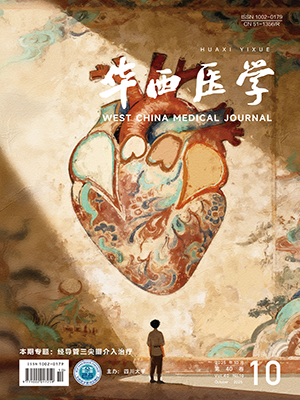| 1. |
李亚茜, 王会, 周鸿. 剪切波弹性成像和表面肌电图评估针刺联合推拿治疗颈肩肌筋膜疼痛综合征的效果. 临床超声医学杂志, 2020, 22(12): 893-897.
|
| 2. |
Fleckenstein J, Zaps D, Rüger LJ, et al. Discrepancy between prevalence and perceived effectiveness of treatment methods in myofascial pain syndrome: results of across-sectional, nationwide survey. BMC Musculoskelet Disord, 2010, 11: 32.
|
| 3. |
Galasso A, Urits I, An D, et al. A comprehensive review of the treatment and management of myofascial pain syndrome. Curr Pain Headache Rep, 2020, 24(8): 43.
|
| 4. |
马明, 孙武东, 汤从智, 等. 深层肌肉刺激联合本体感觉神经肌肉促进疗法治疗颞下颌关节紊乱病的疗效观察. 中华物理医学与康复杂志, 2015, 37(11): 848-850.
|
| 5. |
赵保礼, 赵智, 张立庄, 等. 筋膜松解术联合核心肌群训练治疗非特异性下背痛的疗效观察. 中华物理医学与康复杂志, 2020, 42(3): 239-241.
|
| 6. |
葛瑞东, 白硕, 郭京伟, 等. 局部肌肉振动对男性慢性非特异性腰痛患者腰背肌疲劳的即刻效应. 中国康复医学杂志, 2019, 34(3): 287-292.
|
| 7. |
陈勤, 漆潇, 张小君, 等. 半导体激光与 DMS 治疗腰肌劳损 105 例临床疗效研究. 激光杂志, 2016, 37(8): 149-152.
|
| 8. |
Fontana TL, Richardson CA, Stanton WR. The effect of weight-bearing exercise with low frequency, whole body vibration on lumbosacral proprioception: a pilot study on normal subjects. Aust J Physiother, 2005, 51(4): 259-263.
|
| 9. |
傅彩峰, 高朝, 楚妍峰, 等. 超声波联合悬吊运动疗法治疗腰肌筋膜疼痛综合征的临床观察. 中华物理医学与康复杂志, 2016, 38(2): 153-155.
|
| 10. |
Urits I, Charipova K, Gress K, et al. Treatment and management of myofascial pain syndrome. Best Pract Res Clin Anaesthesiol, 2020, 34(3): 427-448.
|
| 11. |
Gezginaslan Ö, Gümüş Atalay S. High-energy flux density extracorporeal shock wave therapy versus traditional physical therapy modalities in myofascial pain syndrome: a randomized-controlled, single-blind trial. Arch Rheumatol, 2019, 35(1): 78-89.
|
| 12. |
中华医学会. 临床诊疗指南: 物理医学与康复分册. 北京: 人民卫生出版社, 2005: 105-108.
|
| 13. |
Kim CM, Park JW. Meta-analysis of the effects of physical modality therapy and exercise therapy on neck and shoulder myofascial pain syndrome. Osong Public Health Res Perspect, 2020, 11(4): 251-258.
|
| 14. |
Shah JP, Danoff JV, Desai MJ, et al. Biochemicals associated with pain and inflammation are elevated in sites near to and remote from active myofascial trigger points. Arch Phys Med Rehabil, 2008, 89(1): 16-23.
|
| 15. |
苏晗, 崔俊武, 王晶晶, 等. 肌筋膜疼痛综合征的治疗研究进展. 广西医学, 2021, 43(5): 621-624.
|
| 16. |
韩晓阁. 深部肌肉刺激联合 rTMS 对慢性肌筋膜疼痛综合征患者神经生物标记物表达的影响. 中国疼痛医学杂志, 2016, 22(9): 645-647.
|
| 17. |
郄淑燕, 王丛笑, 孙晓静, 等. 局部振动治疗对颈肩痛患者肌肉物理特性及表面肌电信号的影响. 中华物理医学与康复杂志, 2017, 39(1): 30-33.
|
| 18. |
程凯, 魏光仪, 罗汉华, 等. 深层肌肉刺激治疗腰臀肌筋膜炎的临床疗效研究. 颈腰痛杂志, 2021, 42(5): 751-752.
|
| 19. |
玄其文, 顾伟. 运动疗法治疗肌筋膜疼痛综合征的研究进展. 第二军医大学学报, 2021, 42(8): 911-915.
|
| 20. |
蔡春水, 魏鲁青, 尹杰, 等. 运动处方治疗慢性颈肌筋膜疼痛综合征的早期疗效观察. 中国矫形外科杂志, 2011, 19: 1964-1966.
|
| 21. |
郭玲, 桑志成, 张丁丁, 等. 实时剪切波弹性成像技术检测斜方肌非自主性紧张的可行性分析. 中华超声影像学杂志, 2015(4): 333-336.
|
| 22. |
Yamamoto A, Yamakoshi Y, Ohsawa T, et al. Shear wave velocity measurement of upper trapezius muscle by color Doppler shear wave imaging. J Med Ultrason (2001), 2018, 45(1): 129-136.
|
| 23. |
Vuorenmaa AS, Siitama EMK, Mäkelä KS. Inter-operator and inter-device reproducibility of shear wave elastography in healthy muscle tissues. J Appl Clin Med Phys, 2022, 23(9): e13717.
|
| 24. |
Taş S, Onur MR, Yılmaz S, et al. Shear wave elastography is a reliable and repeatable method for measuring the elastic modulus of the rectus femoris muscle and patellar tendon. J Ultrasound Med, 2017, 36(3): 565-570.
|




